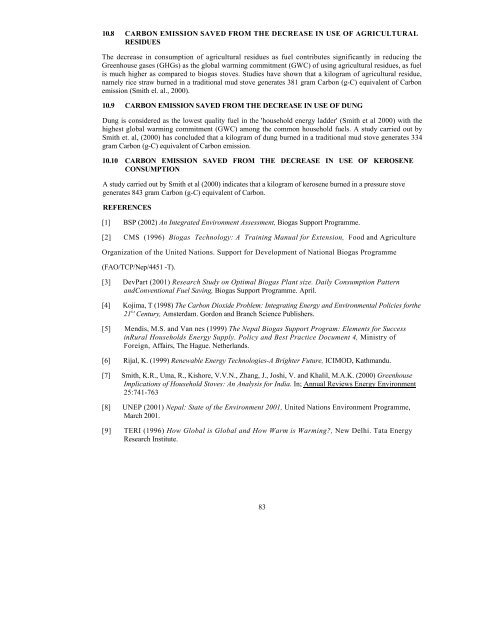download (pdf, 6MB) - SNV
download (pdf, 6MB) - SNV
download (pdf, 6MB) - SNV
You also want an ePaper? Increase the reach of your titles
YUMPU automatically turns print PDFs into web optimized ePapers that Google loves.
10.8 CARBON EMISSION SAVED FROM THE DECREASE IN USE OF AGRICULTURAL<br />
RESIDUES<br />
The decrease in consumption of agricultural residues as fuel contributes significantly in reducing the<br />
Greenhouse gases (GHGs) as the global warming commitment (GWC) of using agricultural residues, as fuel<br />
is much higher as compared to biogas stoves. Studies have shown that a kilogram of agricultural residue,<br />
namely rice straw burned in a traditional mud stove generates 381 gram Carbon (g-C) equivalent of Carbon<br />
emission (Smith el. al., 2000).<br />
10.9 CARBON EMISSION SAVED FROM THE DECREASE IN USE OF DUNG<br />
Dung is considered as the lowest quality fuel in the 'household energy ladder' (Smith et al 2000) with the<br />
highest global warming commitment (GWC) among the common household fuels. A study carried out by<br />
Smith et. al, (2000) has concluded that a kilogram of dung burned in a traditional mud stove generates 334<br />
gram Carbon (g-C) equivalent of Carbon emission.<br />
10.10 CARBON EMISSION SAVED FROM THE DECREASE IN USE OF KEROSENE<br />
CONSUMPTION<br />
A study carried out by Smith et al (2000) indicates that a kilogram of kerosene burned in a pressure stove<br />
generates 843 gram Carbon (g-C) equivalent of Carbon.<br />
REFERENCES<br />
[1] BSP (2002) An Integrated Environment Assessment, Biogas Support Programme.<br />
[2] CMS (1996) Biogas Technology: A Training Manual for Extension, Food and Agriculture<br />
Organization of the United Nations. Support for Development of National Biogas Programme<br />
(FAO/TCP/Nep/4451 -T).<br />
[3] DevPart (2001) Research Study on Optimal Biogas Plant size. Daily Consumption Pattern<br />
andConventional Fuel Saving, Biogas Support Programme. April.<br />
[4] Kojima, T (1998) The Carbon Dioxide Problem: Integrating Energy and Environmental Policies forthe<br />
21 s ' Century, Amsterdam. Gordon and Branch Science Publishers.<br />
[5] Mendis, M.S. and Van nes (1999) The Nepal Biogas Support Program: Elements for Success<br />
inRural Households Energy Supply. Policy and Best Practice Document 4, Ministry of<br />
Foreign, Affairs, The Hague. Netherlands.<br />
[6] Rijal, K. (1999) Renewable Energy Technologies-A Brighter Future, ICIMOD, Kathmandu.<br />
[7] Smith, K.R., Uma, R., Kishore, V.V.N., Zhang, J., Joshi, V. and Khalil, M.A.K. (2000) Greenhouse<br />
Implications of Household Stoves: An Analysis for India. In; Annual Reviews Energy Environment<br />
25:741-763<br />
[8] UNEP (2001) Nepal: State of the Environment 2001, United Nations Environment Programme,<br />
March 2001.<br />
[9] TERI (1996) How Global is Global and How Warm is Warming?, New Delhi. Tata Energy<br />
Research Institute.<br />
83
















